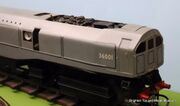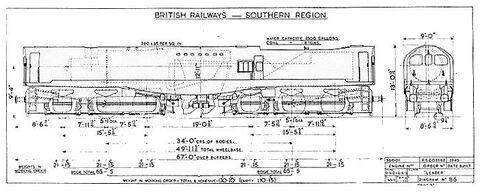Leader-class steam locomotive prototype, live steam, gauge 1 (Carl Wedkin-Snaith)
| Exhibit |
|---|
Leader-class steam locomotive prototype, live steam, gauge 1 (Carl Wedkin-Snaith) (i) (i)
|
 |
| location: |
|
Arch One , Area 85 Glamour of Brighton |
The Leader-class steam locomotive, designed by Oliver Bulleid, was a novel and highly experimental class of engine built at Brighton Works in the 1940s that looked more like a diesel or electric engine (or an oversized London Underground train!) than a conventional steam engine.
The prototype-grey gauge 1 steam model of "36001" in the Museum’s "Glamour of Brighton" exhibition was built by Carl Wedkin-Snaith. It's steam-powered and spirit-fired.
History
By the 1940's, diesel end electric locomotives were showing a number of operational advantages over conventional steam locos. Having the driver’s cab at the front on a diesel made it much easier for the driver to see where they were going, and performing shunting and coupling tasks with a steam locomotive tended to involve the driver hanging out of the side of the cab to try to get a better look.
Diesel and electric engines also tended to be designed for reversibility, with a cab at each end. A conventional-looking steam engine with the boiler at the front (followed by the driver’s cab, and then the tender) could be designed to run backwards just as easily as forwards, but the driver’s cab wasn't particularly designed for rearward visibility and was often open at the back. Without the ability to run in both directions, railway lines often needed turntables to turn a steam engine around before it could retrace its path, or when a sufficiently-large turntable wasn't available, needed to send steam locomotives out on additional journeys around the network to do the equivalent of a "three point turn".
Bulleid set out to redesign the basic concept of the steam locomotive to make it look and function more like the diesel and electric units that were threatening to take over. Bulleid’s "Leader Class" loco design had a forward-looking driver’s cab at the front, a duplicate rear-looking cab at the back, a central cab for the fireman, and a corridor running down the inside of the frame connecting them together, with the steam boiler offset to one side to make room. Not only could the driver run the engine in either direction, from either end, they could move from one end of the locomotive to the other without having to go outside.
In addition, the Leader’s drive wheels weren't fixed rigidly to the body but were on two 0-6-0 power bogeys. If a drive unit developed a fault, the bogey could be swapped out without taking the entire train out of service. Its twelve drive wheels would give the Leader locos excellent traction, and the simple-shaped exterior casing meant that the locos could be cleaned by running them through the same "car wash" -type facilities that were used for cleaning carriages. The Leader prototypes also introduced other engineering innovations (such as the chain drive) to steam.
Difficulties
The development of the Leader class prototypes uncovered a series of persistent problems, from the type of firebox insulation to the unbalanced weight distribution due to the sideways offset of the boiler (positioned to allow space for the corridor), to difficulties with some of the innovative new systems and mechanisms, to working conditions and safety issues for the driver and fireman (who had no obvious means of escape if the engine toppled over onto its corridor side). The fireman's position was too hot and too unventilated, the offset boiler (visible as a circular dotted outline offset in the front-view on the plans, above) gave the locomotive an unbalanced weight distribution, and when the corridor side was loaded with heavy ballast to compensate, the locomotive was badly overweight, and had additional limitations on the track that it was allowed to run on.
The Leader class never went into production, and its prototypes were scrapped, and no longer exist.
Related locomotives
A more successful dual power-bogey locomotive design that did go onto production was the Garratt. The Garratt resembled a more conventional steam locomotive, but suspended between independent power bogies front and back, and with front and back tenders.
Other models
We did think that this was the only working gauge 1 model of a Leader-class loco known to exist, but it turns out that at least one other has been built by Barrett Engineering.
Further Reading and links
- Ian Roberston, Leader: Steam’s Last Chance (Sutton Publishing, 1988) ISBN 0862993768
- A brief pictorial history of Oliver Bulleid's Leader class steam locomotive for the Southern Railway
- The Gauge One Model Ralway Association, "G1MRA" (g1mra.com)
- The "Barrett Engineering" model (youtube.com) – video



